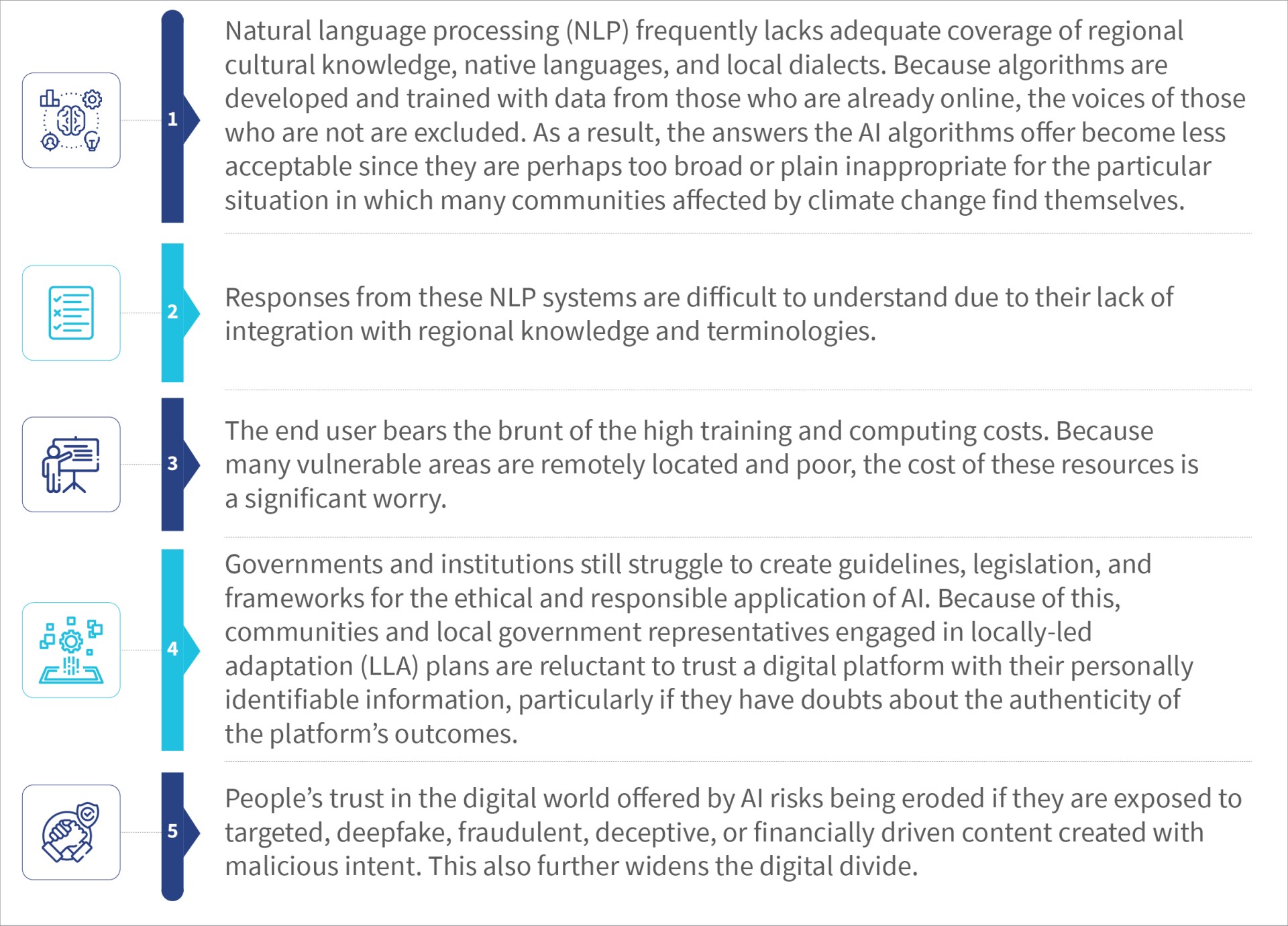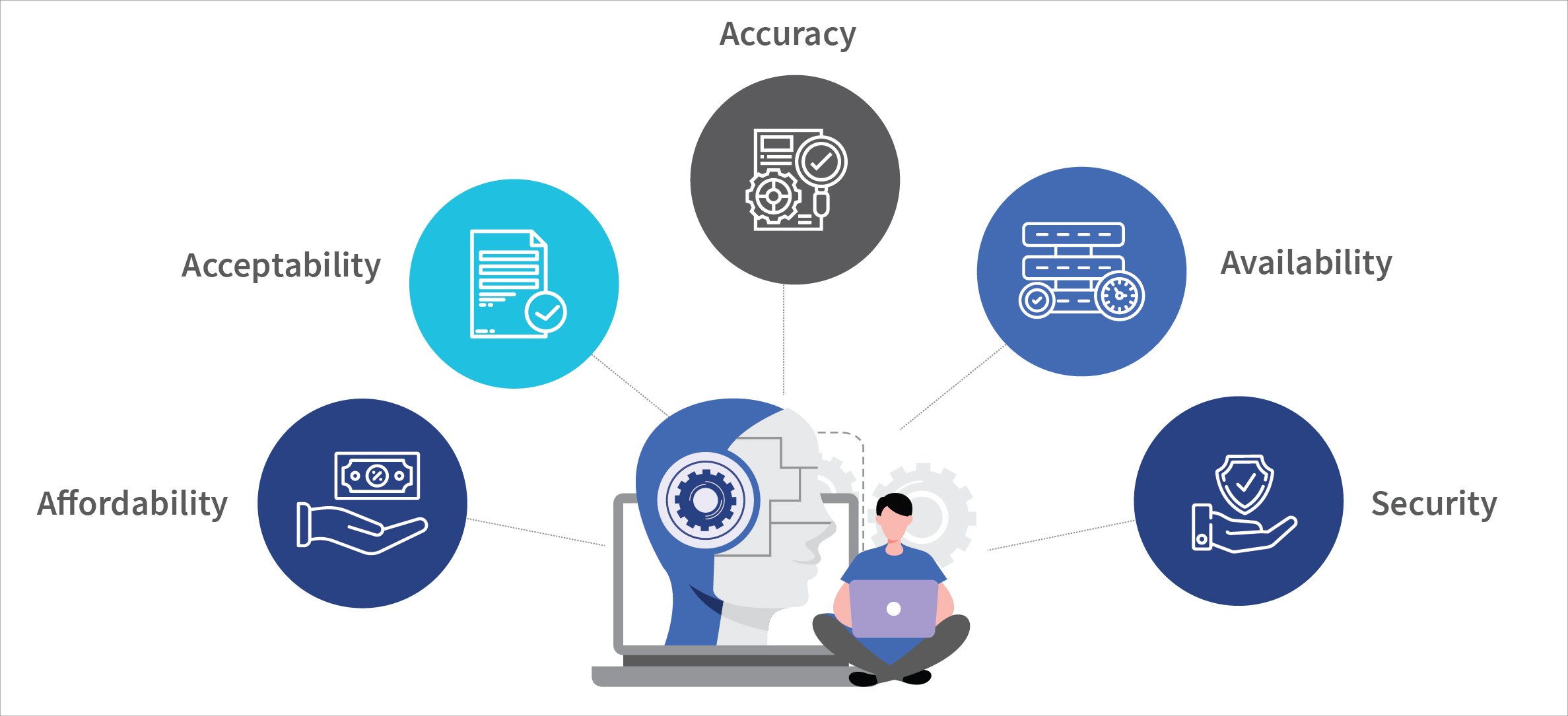Can AI help with locally-led adaptation: The solutions
 by Debarshi Chakraborty and Kunj Daga
by Debarshi Chakraborty and Kunj Daga Mar 1, 2024
Mar 1, 2024 5 min
5 min
We have examined the causes and effects of the digital divide—where the most vulnerable members of society are stranded in an analog world. Despite efforts to close this gap through AI-powered modern technologies, the adoption and penetration of these technologies have fallen well short of expectations. Read the blog to learn about the solutions.
We have examined the causes and effects of the digital divide—where the most vulnerable members of society are stranded in an analog world—in the blog “Can AI help with locally-led adaptation? The challenges.” Despite efforts to close this gap through AI-powered modern technologies, the adoption and penetration of these technologies have fallen well short of expectations. We can summarize the problems as follows.

We need to address five aspects here:

Data is the main source of dependency for any nation’s AI journey. Governments must create their frameworks, policies, and goals for AI and engage in its development. Affordability will be easier to achieve if the state invests to collect, preserve, process, and operationalize data. For example, India’s AIRAWAT AI supercomputer, which is among the world’s 100 most powerful systems, helps enable technology and AI for the welfare of common people and contributes to their socioeconomic growth.
The National Strategy for Artificial Intelligence lays down the foundational roadmap to India’s AI journey. The work on the Indic language set allows content to be collected and delivered in Indian languages. With state backing to process vast amounts of data, private businesses can create last-mile solutions and delivery apps that are more cost-effective for the underprivileged population. These private institutions can then focus on educating the public on digital platforms. Here, too, the state’s capacity for broadcasting and information dissemination can be used to reduce the cost further.
Development organizations have also played a big role to bring down the affordability cost through their support of initiatives for multiple public use cases, such as healthcare to the doorstep, tele-consultancy, and medical interventions to detect symptoms, among others. For example, People+ai has been working on a strategic initiative Adbhut India (AI), which seeks to build ecosystem-level solutions actively across a spectrum of multiple projects in agriculture, healthcare, education, and governance. As more and more players participate in the ecosystem collectively and competitively, the quality of solutions will improve, and their costs will fall as per the market economics.
The acceptability of the solution for LLAs depends on the content’s localization and relevance. This means that the content should feature native terms and dialects wherever suitable. To help, the state or pertinent departments should create, oversee, and implement a local lexicon and glossary that can supplement the trained LLM models with techniques, such as retrieval-augmented generation (RAG). RAG is a method that uses information retrieved from external sources—in this case, the localized glossary—to improve the precision and dependability of generative AI models. For example, the armyworm pest has different names in India, such as “girni sena” or “fauji keeda.” In such cases, the RAG technique will supplement the LLM with a localized glossary of names. Similarly, OpenHathi by Sarvam AI has been developing an ecosystem with open models and datasets to encourage innovation in Indian language AI.
The local climate, soil, landscape, temperature range, and species, among other factors, should also augment the trained data to make the delivered content more accurate. Some data is available in government departments in silos, but its quality in terms of structure, relevance, and accuracy remains a big concern. Development organizations can play a vital role here to facilitate data collection by encouraging the use of digital technologies for LLA.
Availability is easy to achieve if all former aspects are in place. The design of the “last-mile” application should be intuitive for users and seek to reduce the digital divide through a suitable delivery mechanism. People who cannot read can be helped using audio or video content. Places with poor or no internet connectivity can be included through the use of state capacity of information broadcast and community service. Most of the LLAs are “employed” to render their service, and these organizations should also contribute through their corporate social responsibility. As discussed earlier, NLP trained in local dialects and languages is the key to success.
CICO agents, MFI staff, agricultural extension agents, and CBO or NGO staff can help those without smartphones access AI solutions. These agents can provide awareness, trust, and capacity building for AI solutions that require digital payments or transactions, such as e-commerce platforms, digital credit, or insurance products. The agents can enable people to invest in or adopt AI solutions for agriculture, such as smart irrigation systems, precision farming tools, or crop monitoring devices. Agricultural extension agents can also provide feedback and evaluation for AI solutions and facilitate the exchange of knowledge and best practices among farmers and other stakeholders. CBO or NGO staff can also advocate for the rights and interests of farmers, especially smallholders, and women, and ensure that AI solutions are ethical, responsible, and inclusive.

Security and privacy are the most difficult aspects of all the concerns. Technology is just a tool, a weapon that can be used for both positive and negative outcomes. Any technology’s positive intent, promises, and capability have never been able to outrun the malicious intent to exploit loopholes, gaps, and back gates left unguarded due to a lack of strong foundational policies, laws, frameworks, checks, and measures. A coordinated and collaborative approach is required among multinational governments and private institutions to share, adapt, and enforce these countermeasures to keep bad elements at bay as far as possible.
Laws now need to go beyond border jurisdiction to spread the cover. Nations can no longer match the potential of AI in isolation if they want to ensure the safety and privacy of their citizens’ data and well-being. This is particularly important in the context of farmers, as discussed in the Climate Resilient Agriculture Virtual Club. Policymakers and regulators must develop farmer-centric data governance guidelines to implement fair and equitable data governance models that prioritize farmer participation even as they guard farmers against disadvantages and exploitation.
People hesitate to overcome the digital divide primarily because of a fear of fraud, cybercrimes, and misuse of personal information. Interestingly, advanced AI can analyze non-personal data over time to identify, for instance, farms and their owners, even without direct access to personal information. Digital literacy must be improved to address the hesitation. Governments and nonprofits must actively educate farmers on the digital skills needed for their development in rural areas. This education should also cover their rights and obligations in the digital world. Moreover, it is time for laws to recognize the “right to consent” as a basic right and integrate it into the educational curriculum for all citizens.
Conclusion
We must tackle the challenges of affordability, availability, acceptability, accuracy, and security to successfully integrate AI into development initiatives, particularly for people with low literacy. AI adoption depends on comprehensive data management and supportive government policies. Localization of solutions to align with cultural and linguistic needs is key to better acceptability and accuracy, while accessible design and community engagement are vital for broad availability. If security and privacy concerns are to be addressed, coordinated efforts will be needed across governments and institutions to establish protective measures and ethical standards.
A focused effort on technological innovation, digital literacy improvement, enactment of supportive legislation, and multi-sector collaboration is imperative. Such a holistic strategy will address immediate challenges and position AI as a powerful tool to foster inclusive LLA and, indeed, development in a broader way.
Written by


Leave comments